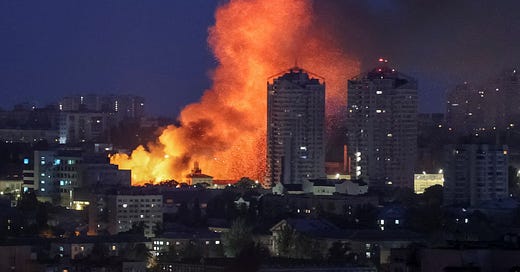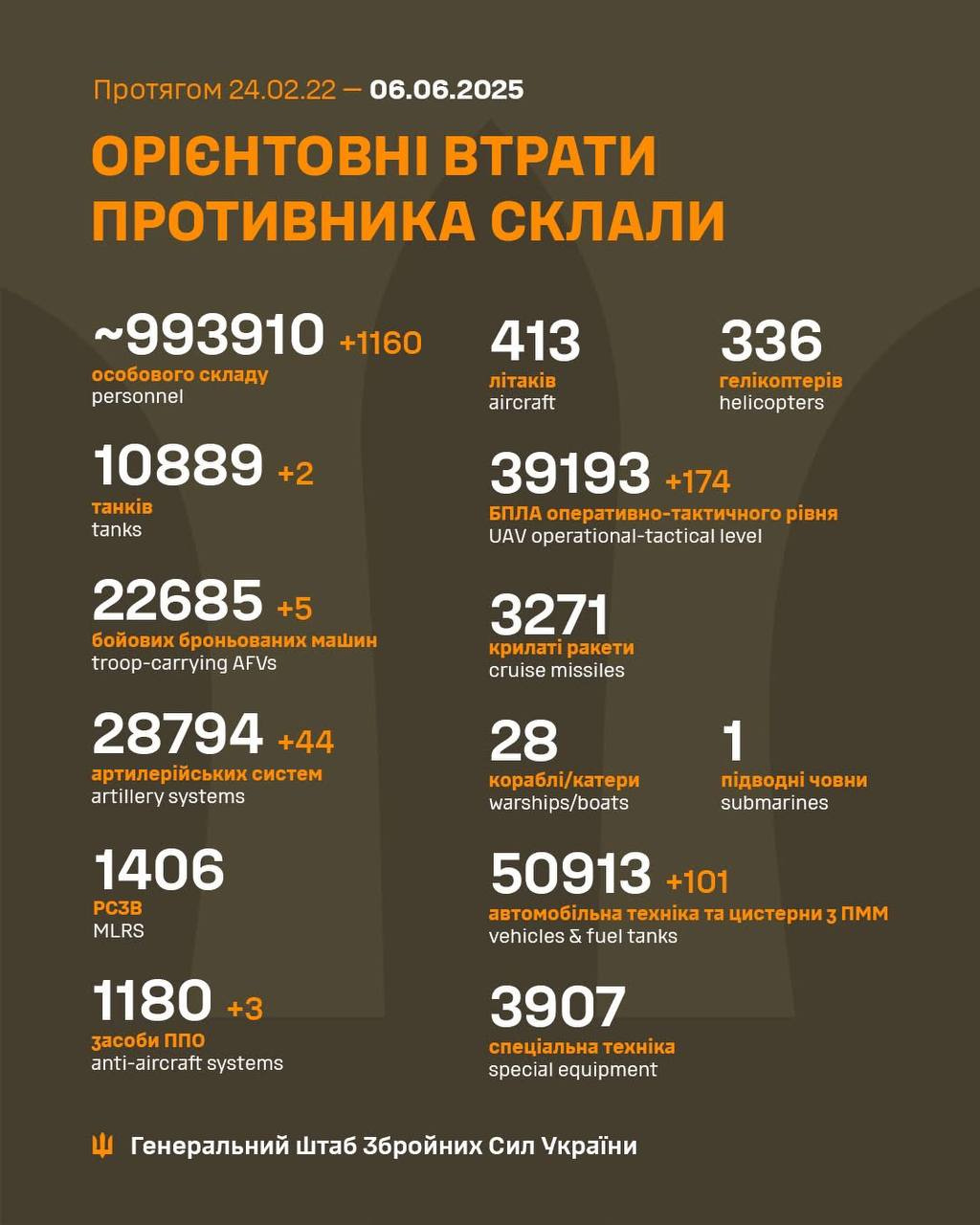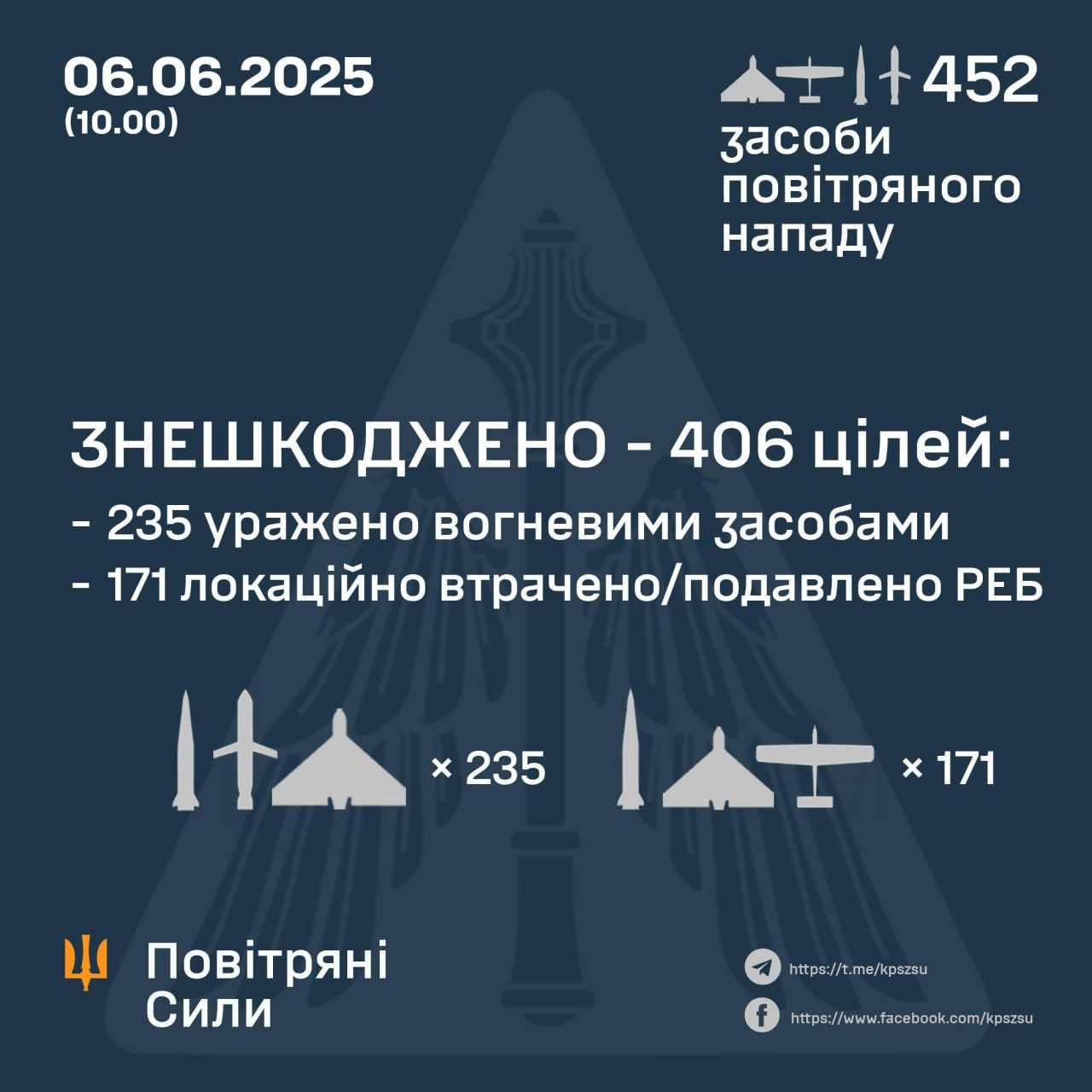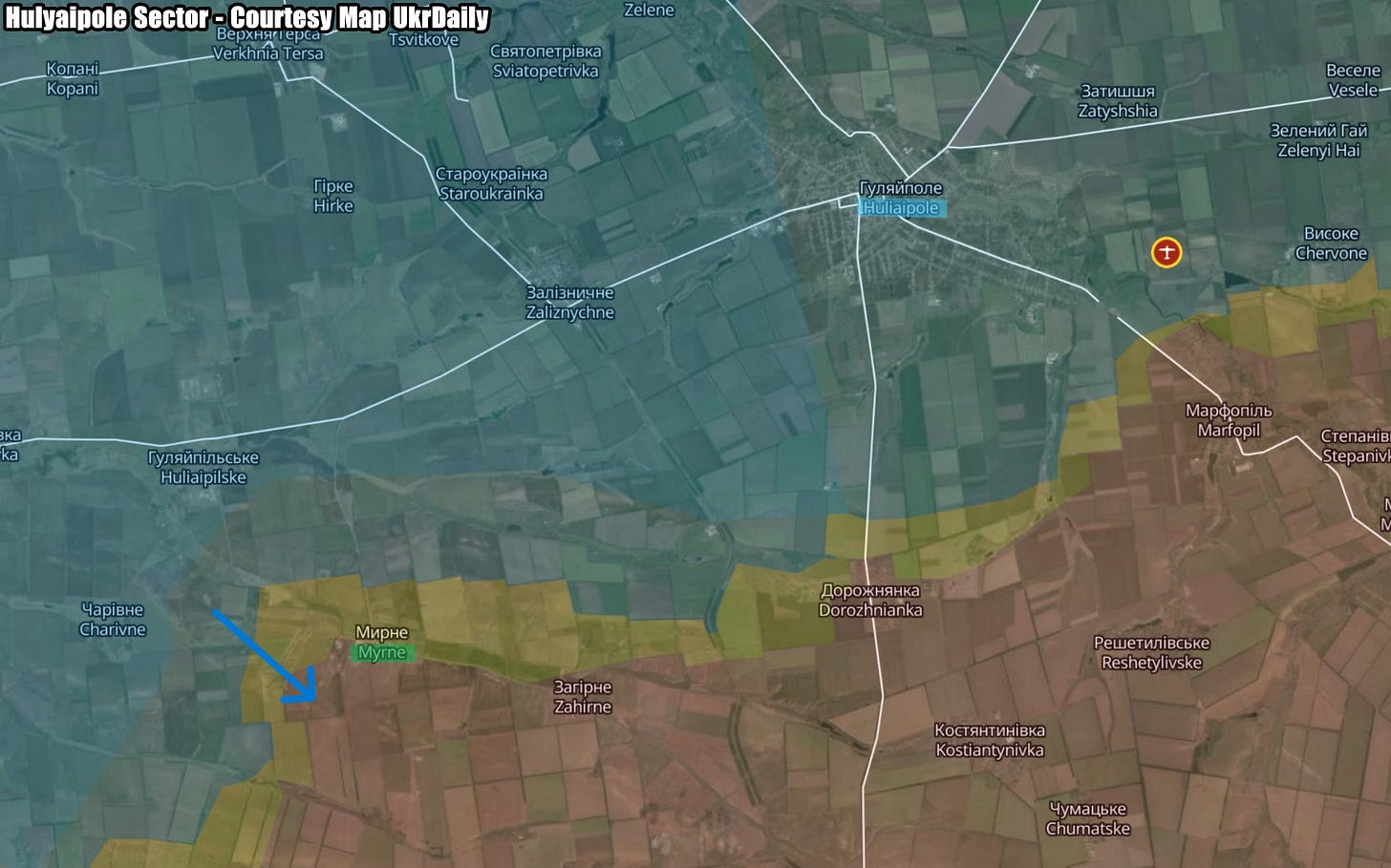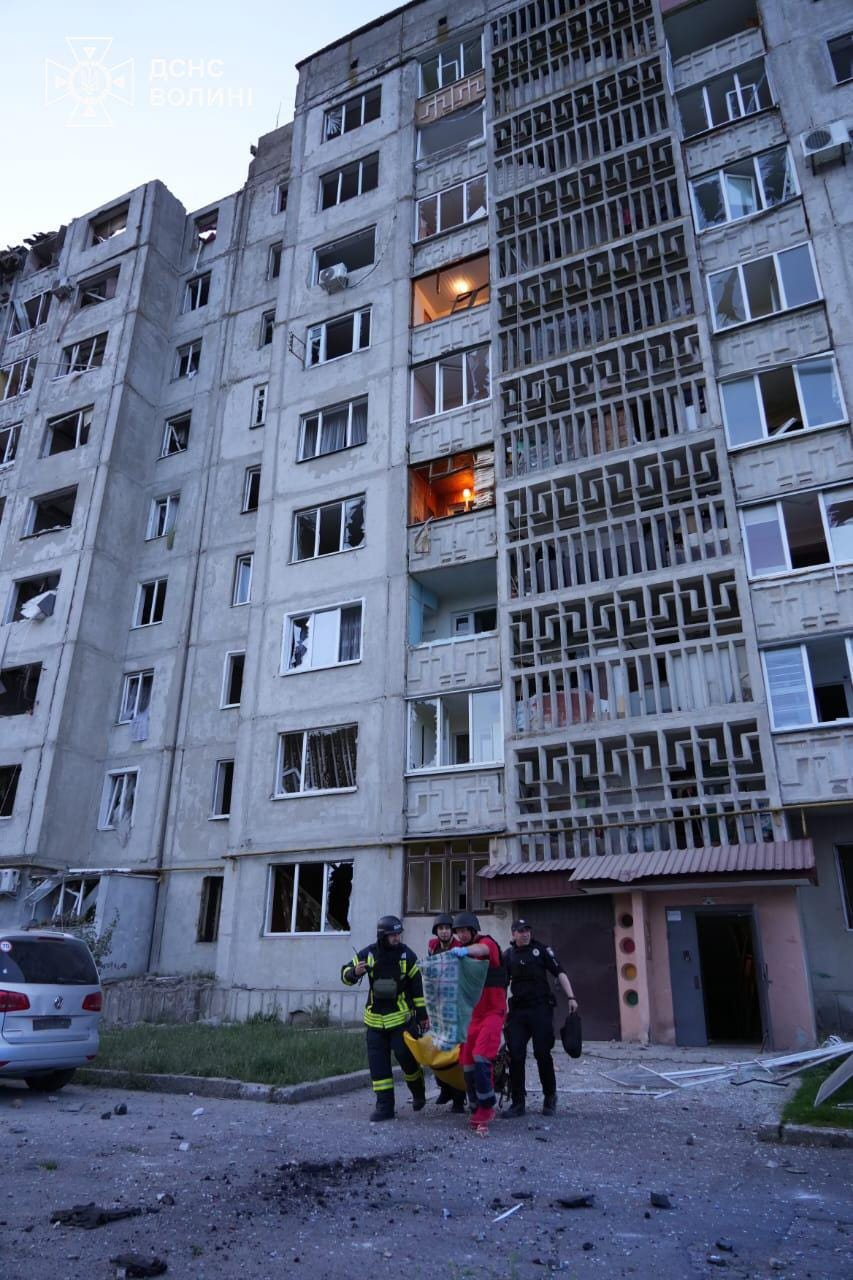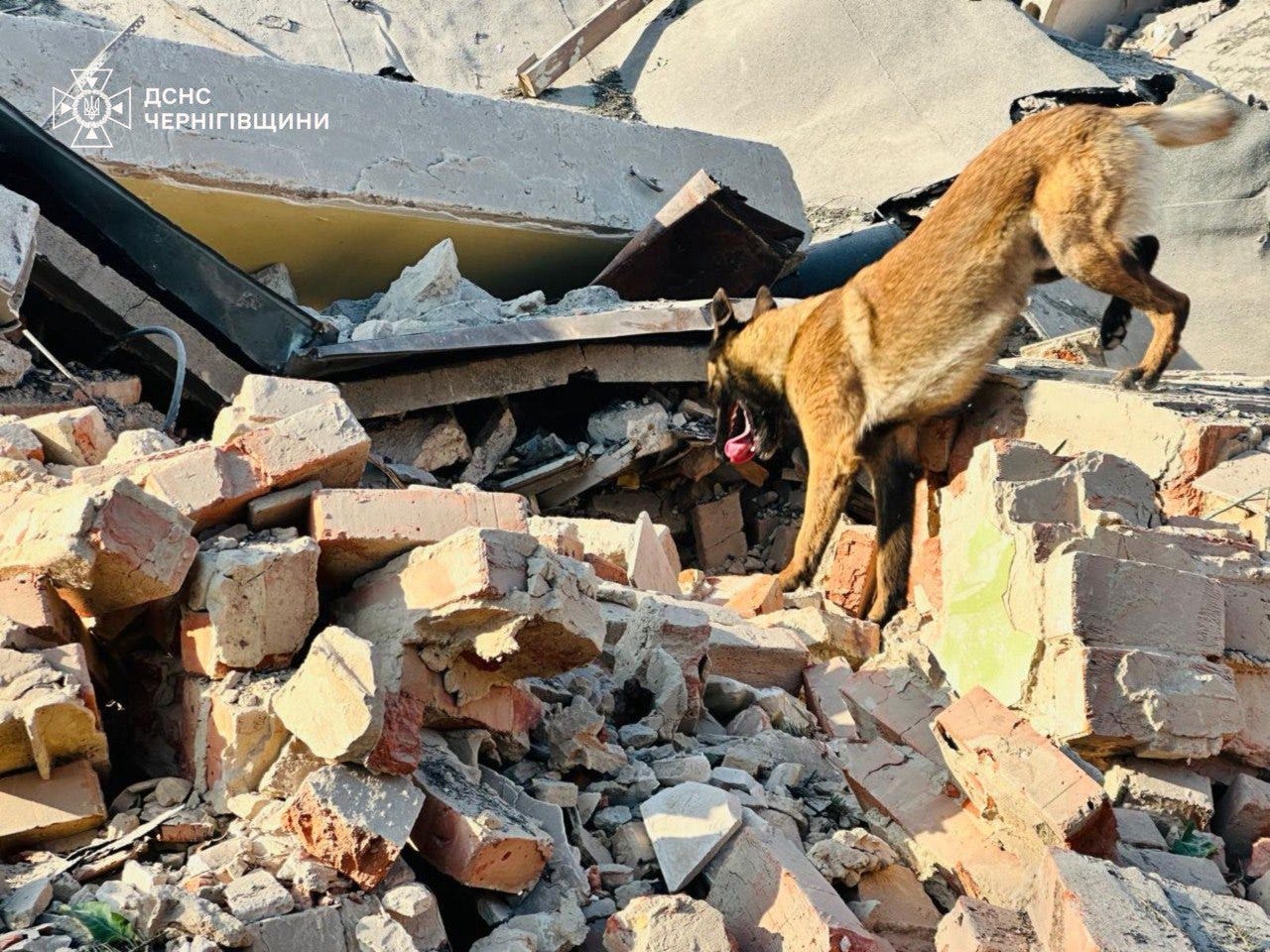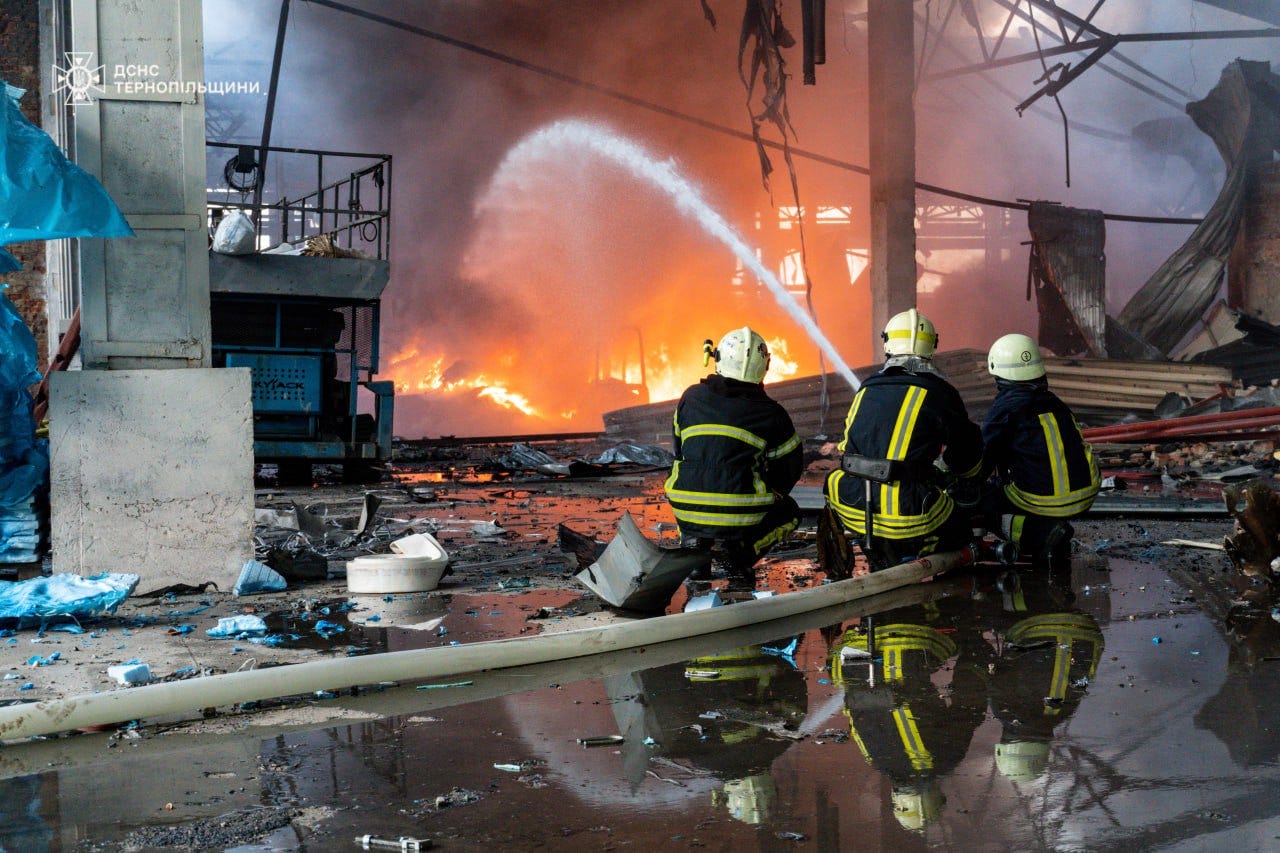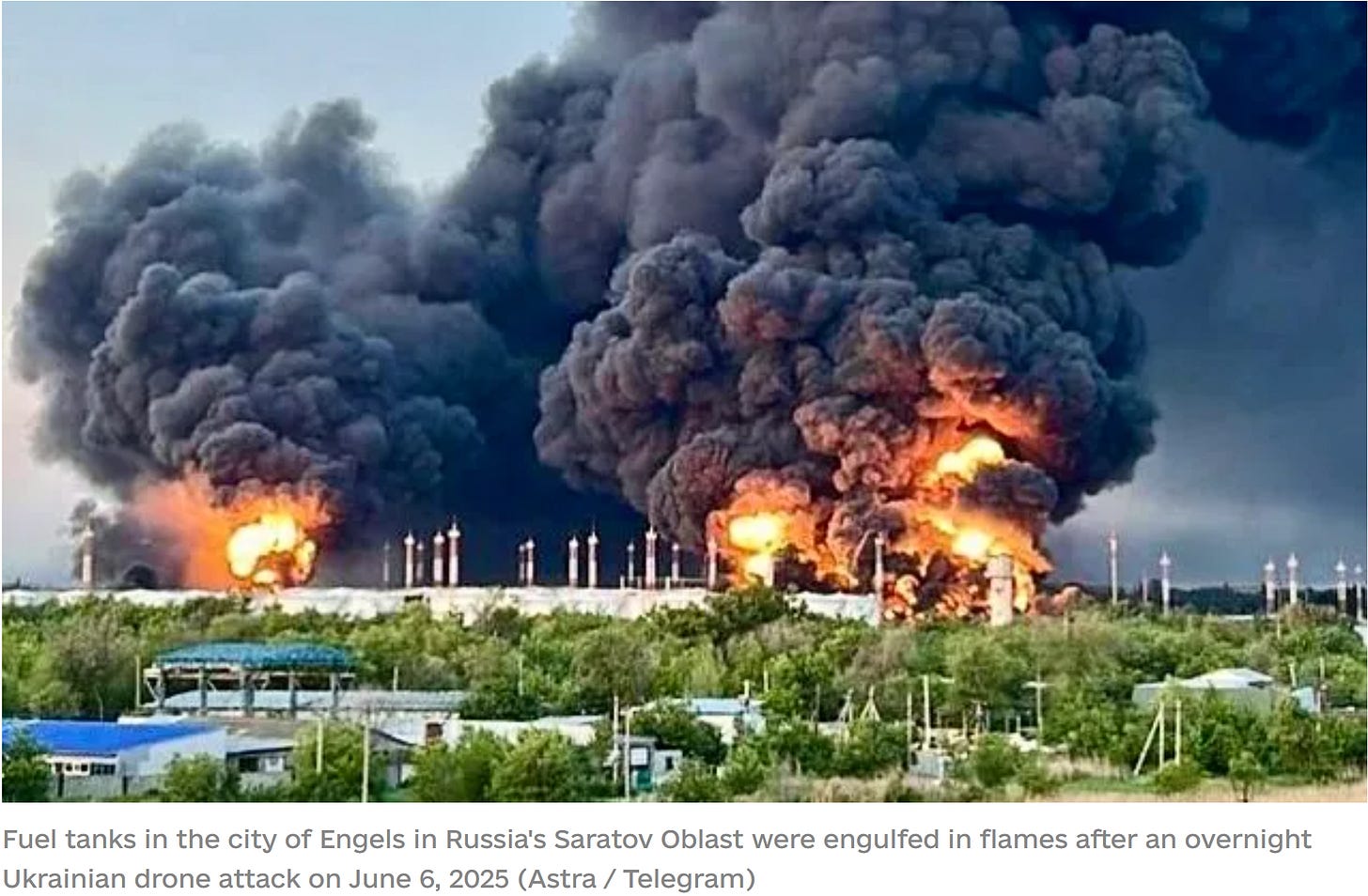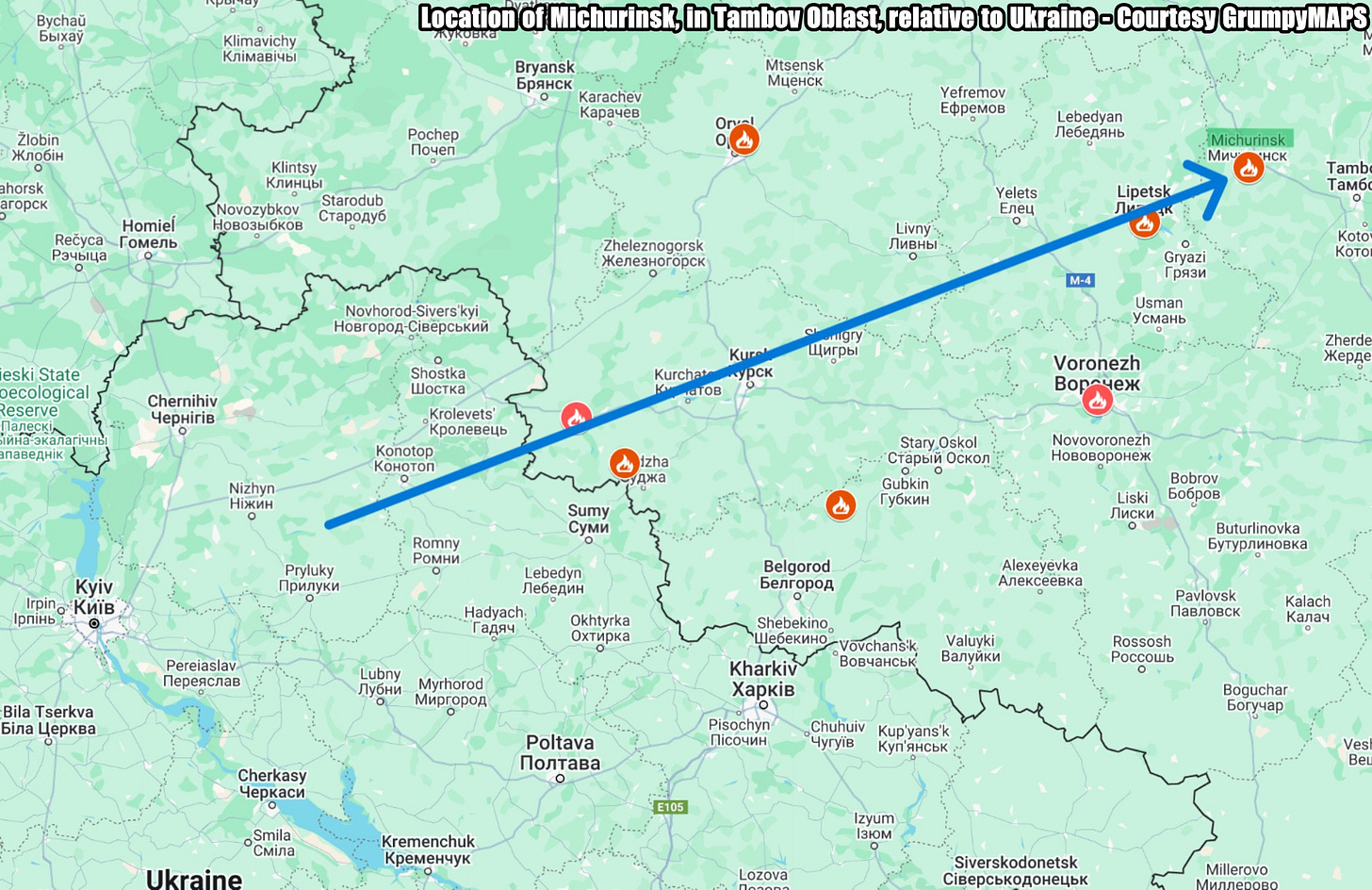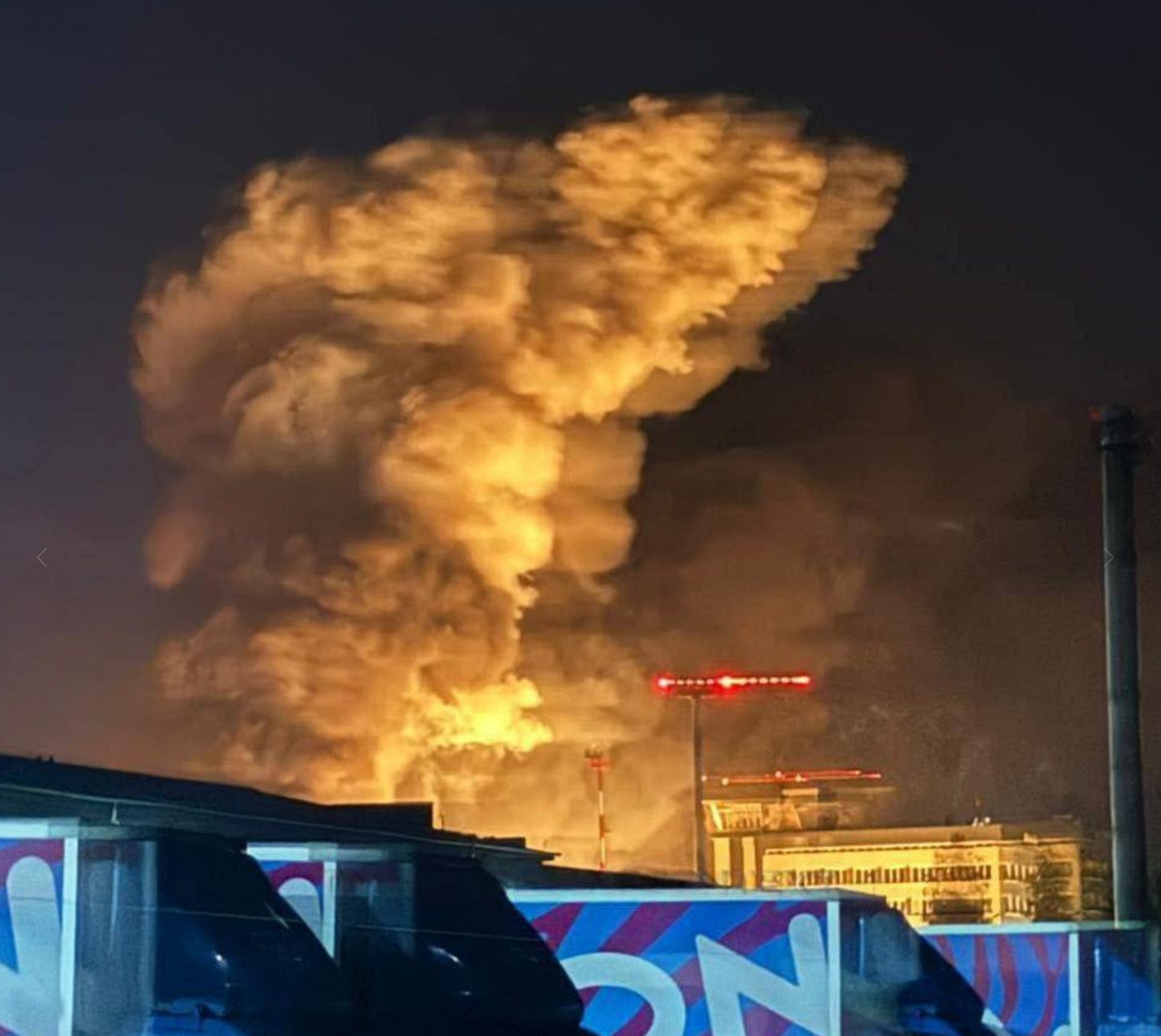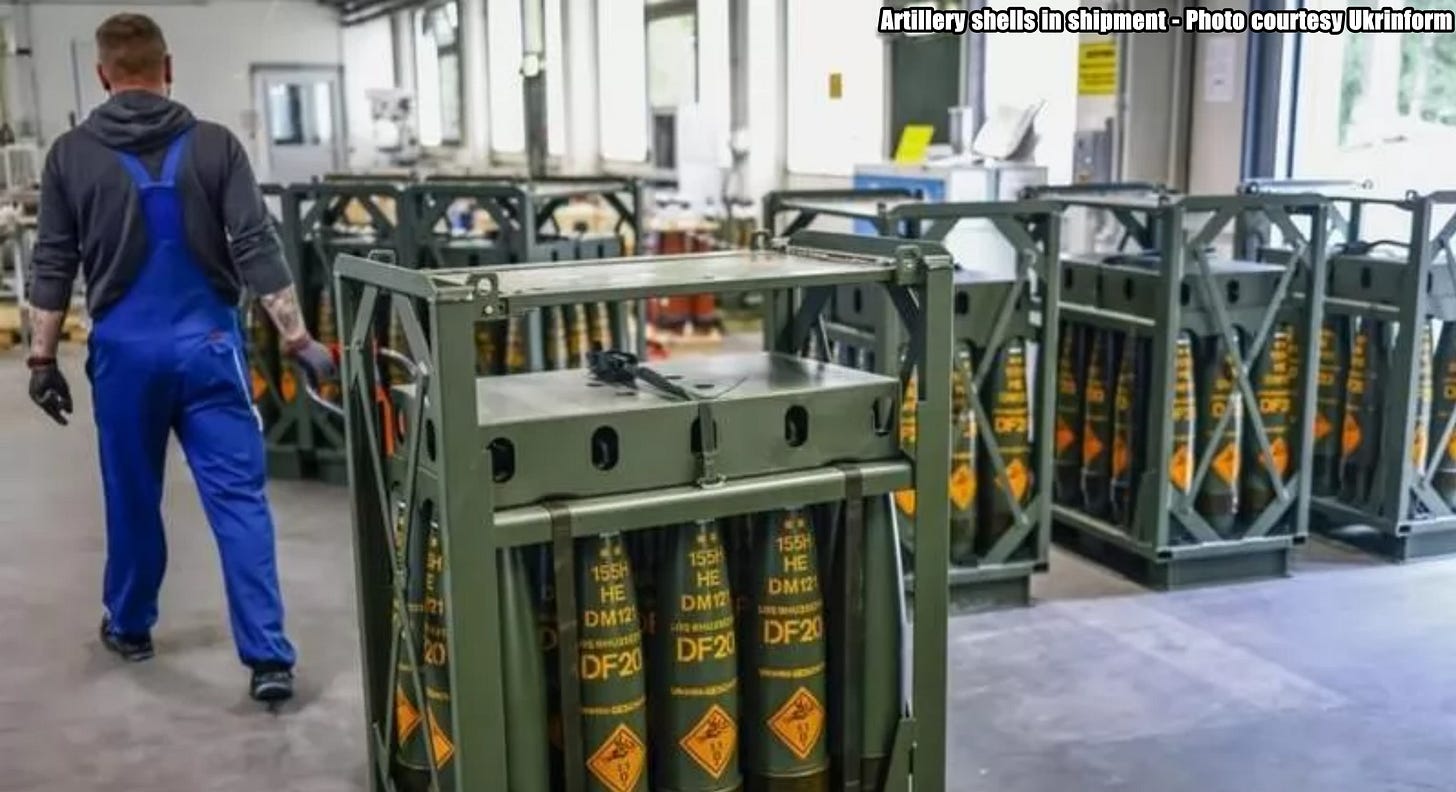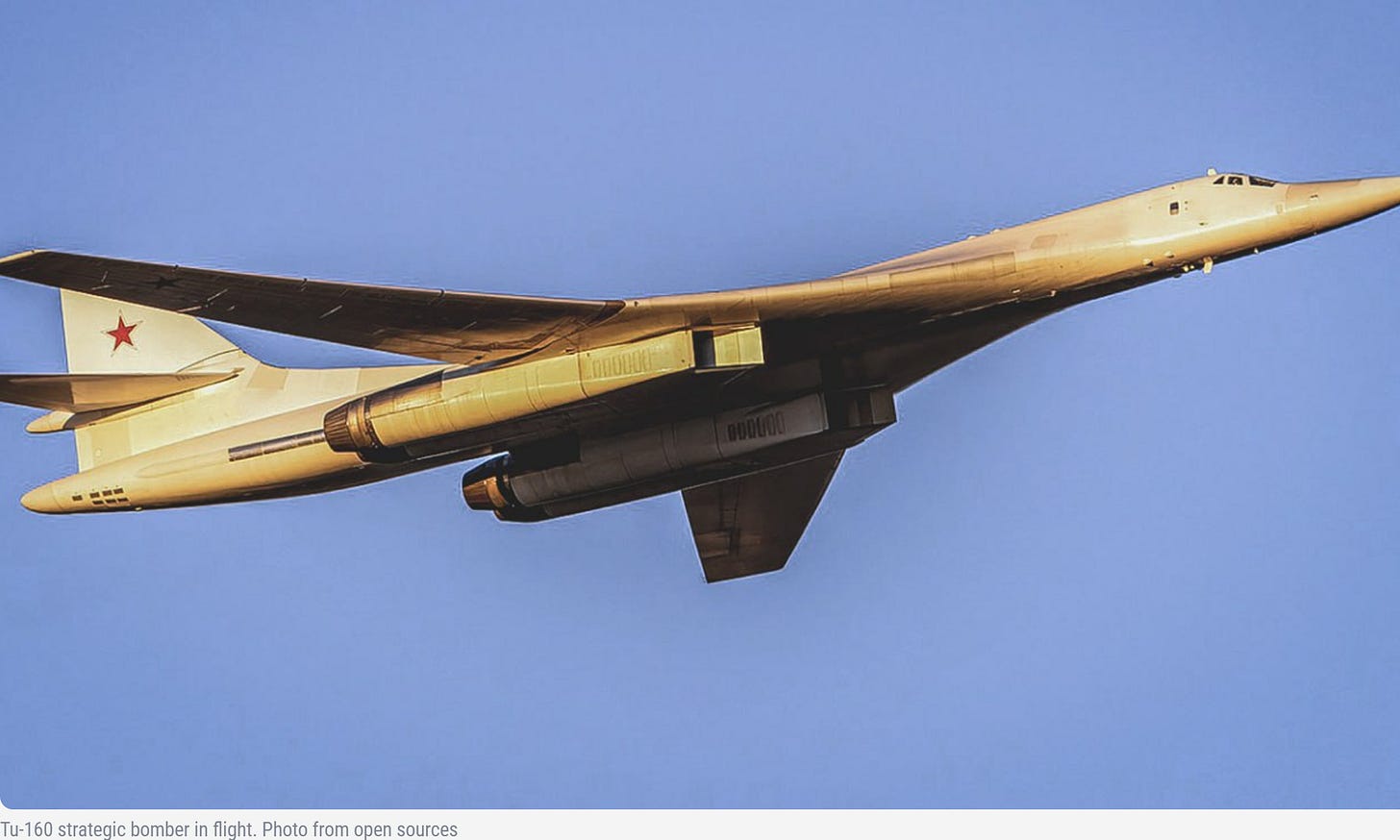Slava Ukraini! In early 2022 I began a Telegram channel aggregating news from a number of sources daily on the war in Ukraine. In June 2023 I began providing a daily draft for the Ukraine War Brief Podcast collecting news from over 70 sources daily, which formed the basis of the script. While the Podcast no longer exists I have continued to make this Brief available for my followers here on Substack for those who wish to keep up with the news from the war.
If you find the Brief informative I would appreciate it if you shared it with others.
All the latest news on the Russo-Ukraine War 6 days per week
ALONG THE CONTACT LINE
GSAFU Morning Report
For: Jun 6, 2025
The General Staff of the Armed Forces of Ukraine in its Operational Information update at 08:00 on Jun 6 stated that day 1199 of the full-scale invasion of the Russian Federation against Ukraine had begun.
The situation on the line of combat remains tense in some sectors. Ukrainian defenders continue to actively counteract the Russian aggressor, causing them significant losses in personnel, equipment and technology. Exhausting the enemy along the entire front line and continuing to disrupt the plans of Russian occupiers to advance deeper into the territory of Ukraine.
During the past day, 204 combat engagements took place.
Yesterday aviation, missile troops and artillery of the Defense Forces hit 12 concentration areas of personnel, arms and military equipment, 6 artillery, ammunition warehouse and enemy BPLA control point.
Over the past 24 hours, the enemy carried out 1 missile strike, 53 air strikes, used 3,500 attack drones and fired approximately 5,950 artillery shells across the positions of Ukrainian forces and civilians.
Air Force Daily Report
406 ENEMY UAVS DESTROYED
➖➖➖➖➖➖➖➖➖
On the night of June 6 (from 8:00 p.m. on June 5), the enemy attacked with 452 air attack vehicles:
- 407 Shahed type strike UAVs and simulator drones of various types from the following directions: Kursk, Orel, Millerovo, Shatalovo, Primorsko-Akhtarsk - RF, Gvardiyskoe - TOT of Crimea;
- 6 Iskander-M/KN-23 ballistic missiles from Kursk and Voronezh regions – Russia;
- 36 Kh-101 cruise missiles from Tu-95MS/Tu-160MS strategic aircraft from the airspace of the Saratov region, over the Caspian Sea;
- 2 Iskander-K cruise missiles from the Dzhankoy region of the Crimean Autonomous Republic;
- 1 Kh-31P anti-radar missile from a tactical aircraft over the Black Sea.
The air attack was repelled by aviation, anti-aircraft missile troops, electronic warfare and unmanned systems units, and mobile fire groups of the Defense Forces of Ukraine.
According to preliminary data, as of 10:00, air defenses neutralized 406 enemy air attack vehicles throughout the country:
- 199 enemy Shahed UAVs (drones of other types) were shot down by fire, 169 were lost/suppressed by electronic warfare;
- 4 Iskander-M/KN-23 ballistic missiles, two more did not reach their targets (lost in location);
- 30 X-101 cruise missiles;
- 2 Iskander-K cruise missiles.
Enemy airstrikes were recorded in 13 locations, and downed aircraft (fragments) fell in 19 locations.
Combat Operations in the Russian Federation
There has been no significant change in the combat environment in this sector since our last report.
The Khortytsia operational-strategic group
(Responsible for the northeastern part of Ukraine. )
Kupyansk Sector: Russian forces recently advanced in the Kupyansk direction.
Geolocated footage published on Jun 5 indicates that Russian forces advanced into central Kindrashivka (north of Kupyansk).
Lyman Sector: Russian forces recently advanced in the Lyman direction.
Geolocated footage published on Jun 5 indicates that Russian forces recently advanced southeast of Zelena Dolyna (north of Lyman).
The Tavria operational-strategic group
(Responsible for the central-eastern and southeastern part of Ukraine.)
Pokrovsk Sector : Russian forces recently advanced in the Pokrovsk direction.
Geolocated footage posted on Jun 5 indicated Russian forces advanced in western Yablunivka.
Hulyaipole Sector: Ukrainian forces recently marginally advanced in the Hulyaipole direction.
Geolocated footage published on Jun 5 indicates that Ukrainian forces recently marginally advanced southwest of Myrne (southwest of Hulyaipole).
The Odesa operational-strategic group
(Responsible for Kherson, Qırım, (also known as Crimea) and the Black Sea.)
There has been no significant change in the combat environment in this sector since our last report.
TEMPORARILY OCCUPIED TERRITORIES
Nothing major to report.
THE HOME FRONT
5 killed, 73 injured in Russian attacks on Ukraine over past day.
At least five civilians were killed and 73 others injured in Russian attacks across Ukraine over the past 24 hours,the Kyiv Independent reported citing regional authorities on June 6.
Kyiv suffered the highest number of fatalities, where at least four civilians were killed and 20 others injured, including 16 hospitalized, according to Mayor Vitali Klitschko.
Multiple fires broke out across Kyiv after strikes hit residential areas and infrastructure.
In Volyn Oblast, 15 people were injured. Drones damaged an apartment building, blowing out windows and tearing through its roof, the local State Emergency Service said.
Ternopil Oblast saw 10 people injured in strikes on civilian areas, including five members of the State Emergency Service, Governor Vyacheslav Negoda reported.
Four people were also wounded in Chernihiv Oblast and multiple homes were damaged by Russian strikes, Governor Viacheslav Chaus reported.
In Donetsk Oblast, six residents were injured — two each in Krynytsi, Pokrovsk, and Kostyantynivka — amid continued Russian shelling, Governor Vadym Filashkin said.
Kharkiv Oblast reported three injuries following attacks on six settlements across the region, Governor Oleh Syniehubov said. In Kherson Oblast, 10 people were injured after Russian forces shelled residential areas and public infrastructure, according to Governor Oleksandr Prokudin.
Poltava Oblast recorded three injuries after missiles hit administrative buildings, commercial warehouses, and a local coffee shop, Governor Volodymyr Kohut said.
In Sumy Oblast, two civilians born in 1966 and 1967 were wounded. Russian troops carried out nearly 110 attacks on 47 settlements in the region, local authorities said.
Zaporizhzhia Oblast reported one fatality amid ongoing Russian attacks on front-line settlements, Governor Ivan Fedorov said.
RUSSIAN WORLD
Ukraine strikes Russian air bases in 'preemptive strike' ahead of drone, missile attack.
Ukrainian forces struck multiple Russian airfields and military facilities overnight on June 6, hours before Russia launched one of its heaviest aerial assaults of the war, the General Staff of Ukraine's Armed Forces reported.
Ukrainian strikes reportedly targeted Engels and Dyagilevo airfields — two key hubs for Russia's long-range bomber fleet, as well as logistics sites in Russia's Kursk Oblast.
Hours after the strikes, Russia attacked Ukraine with 452 drones and 45 missiles, killing at least five people and injuring 73 in one of the largest attacks of the full-scale war.
Engels-2 air base, located in Saratov Oblast, nearly 600 kilometers (370 miles) from Ukraine's front lines, hosts Russia's Tu-95, Tu-22M3, and Tu-160 bombers — aircraft regularly used in missile attacks on Ukrainian cities.
Ukraine's General Staff said a strike ignited large fires at the facility, hitting at least three fuel tanks. Footage and local reports confirmed a significant blaze and numerous explosions in the area.
Saratov Governor Roman Busargin acknowledged a fire at an unspecified "industrial enterprise" and damage from drones to a residential building. No casualties were reported.
The Dyagilevo airfield in Ryazan Oblast, home to air refueling tankers and bomber escort fighters, was also targeted. The General Staff reported fire damage in the area, with Russian air defense activity and explosions recorded. Results of the strike are still being assessed.
Ukraine also claims to have struck a logistics center tied to the 30th Motorized Rifle Regiment of Russia's 72nd Division near Kulbaki in Kursk Oblast.
Russia's Defense Ministry claimed that 174 Ukrainian drones were intercepted overnight across 12 regions of Russia and occupied Crimea.
"Strikes on military infrastructure will continue until the Russian Federation's armed aggression against Ukraine is completely stopped," Ukraine's General Staff said.
The latest wave of Ukrainian strikes underscores Kyiv's evolving long-range strike capability, as well as its efforts to preemptively degrade Russian assets used in air assaults.
The Security Service of Ukraine (SBU) on June 1 launched Operation Spiderweb, a daring mass drone attack that damaged 41 Russian heavy bombers at four key airfields throughout the country.
The operation reportedly targeted A-50, Tu-95, and Tu-22 M3 planes parked at the Belaya, Diaghilev, Olenya, and Ivanovo air bases, causing approximately $7 billion in damage.
Russian weapons plant hit by drones in Tambov Oblast, media reports attacks across country.
Drones struck a Russian military plant in Michurinsk, Tambov Oblast, in the early hours of June 6, the Kyiv Independent reported citing media outlets in Russia.
Attacks were also reported in Russia's Saratov, Moscow, Tula, Belgorod, and Kaluga oblasts.
The JSC Progress Plant in the city of Michurinsk in Tambov Oblast came under fire overnight, Russian Telegram news channels reported, citing local residents. A drone allegedly hit the plant's workshop, causing a fire.
Russian officials have not yet commented on the attack.
The JSC Progress Plant produces high-tech aviation and missile control systems, along with equipment for gas and oil pipelines. The plant was reportedly hit in a previous attack in December 2024.
On the same night, Russian outlets also reported that an oil refinery in Saratov Oblast came under attack. The Kristal Plant, which supplies fuel to the Engels-2 military airfield, was engulfed in flames after a drone strike. Ukraine has targeted the facility in past attacks.
A train derailed in Belgorod Oblast after an explosive device detonated under the tracks, Governor Vyacheslav Gladkov claimed. Part of the track was damaged, but there were no casualties, he said.
In the Russian capital, Mayor Sergey Sobyanin claimed that air defense units repelled 10 drones bound for Moscow. Sobyanin said that emergency services had been dispatched to the sites of the fallen wreckage, but did not disclose information regarding any damage.
Kaluga Oblast Governor Vladislav Shapsha reported that five drones were downed over the region, damaging cars.
In Tula Oblast, air defense units reportedly intercepted two drones. Three people were injured, according to Governor Dmitry Milyaev.
The reported attacks come the same night that Russia launched another large-scale drone and missile attack against Ukraine. The attack killed four people in Kyiv and caused casualties and damage to cities in western Ukraine, far from the front lines.
As peace negotiations stall and Russia refuses to accept a ceasefire, the war has escalated.
Russia intensified aerial assaults on Ukrainian cities in late May, launching some of the heaviest assaults of the full-scale war over three consecutive nights. Less than a week later, Ukraine launched Operation Spiderweb, an audacious mass drone strike that reportedly damaged 41 Russian military planes.
In the days since, Ukraine has continued to target key Russian military assets, launching strikes against missile bases and the Crimean Bridge.
Ukrainian drone attack destroys helicopter at Russian airfield in Bryansk.
Ukrainian drones struck Bryansk International Airport in Russia overnight on June 6, destroying one combat helicopter and damaging another, according to Russian emergency officials cited by independent media outlet Astra.
The attack was part of a broader Ukrainian operation targeting multiple Russian airfields and military facilities the same evening.
According to Astra's sources within Russia's Emergency Situations Ministry, the attack destroyed a Mi-8 helicopter after its onboard munitions detonated. A second aircraft, a Mi-35 helicopter gunship, was also damaged, though the extent of the damage remains unclear.
The strike reportedly caused additional destruction to airport infrastructure and rescue facilities, but no casualties were reported. Sources within Ukraine's special services confirmed to Astra that Bryansk airport was among the intended targets of the attack.
The Mi-8 is a multipurpose utility aircraft used for troop transport, reconnaissance, and close air support. The Mi-35 is a heavily armed assault helicopter derived from the Soviet-era Mi-24, with dual capability for offensive operations and personnel transport.
Both aircraft types are actively used by Russia in its war against Ukraine.
RELATED INTERNATIONAL NEWS
Europe can sustain Ukraine's war effort without US, German general says.
Europe is capable of sustaining Ukraine's resistance against Russia, even if the United States were to decide to completely halt its military support to Kyiv, Reuters reported citing the senior military official in charge of coordinating Germany's arms supplies .
Major General Christian Freuding said NATO's European members plus Canada had already exceeded the estimated $20 billion worth of U.S. military aid provided last year to Kyiv.
They accounted for around 60% of the total costs borne by the Western allies, he said.
"The war against Ukraine is raging on our continent, it is also being waged against the European security order. If the political will is there, then the means will also be there to largely compensate for the American support," Freuding said in an interview.
Ukraine continues to receive weapons deliveries approved by former U.S. President Joe Biden. It is unclear, however, whether his successor Donald Trump will sign off on any new supplies - or allow third countries to purchase U.S. weapons for Kyiv.
Asked how long the Biden-approved deliveries will sustain Kyiv, Freuding said this depended on logistical processes as well as the speed at which Ukraine burns through arms and ammunition, but that the summer seemed a realistic estimate.
"How the American government handles further requests for military support for Ukraine is unclear at the moment. We can't say anything about that," he added.
"In general, the U.S. has a great interest in boosting its own defence industry. I make the cautious assumption that at least purchasing U.S. defence goods, and delivering them to Ukraine, will be possible."
Addressing the potential threat that Russia might pose beyond Ukraine, Freuding said Moscow had a clear plan to reconstitute and grow its military, and was expected to succeed in efforts to double its land forces to 1.5 million by 2026.
"They are recruiting significantly more personnel than they need as replacements for the war in Ukraine. They are producing surplus stocks of ammunition, in particular, which they are 'putting on store'".
Freuding said Russia was also ramping up its military infrastructure, especially in its western military district bordering new NATO member Finland.
Any ceasefire in Ukraine could allow Russia to accelerate its rearmament efforts ahead of a possible large-scale attack on NATO territory, he said. The alliance currently believes this could occur from 2029.
"Of course, a ceasefire could change the threat situation," Freuding said.
EU weighs adding Russia to money laundering ‘grey’ list.
The EU is weighing whether to add Russia to its “grey list” of countries with lax money laundering controls, as Brussels’ lawmakers aim to increase financial pressure on Moscow, the Financial Times reports.
European Commission officials said they were considering adding Russia, a move that a majority of members of the European parliament have been advocating. But no decision has been taken, officials stressed.
Markus Ferber, a German MEP who co-ordinates economic affairs for the centre-right European People’s party, said: “There is huge support for putting Russia on the list.”
The full list requires backing from a majority of MEPs and was expected to be announced this week. But the commission pulled its adoption at the last minute for “administrative/procedural reasons”, a commission spokesperson said, adding it would be adopted early next week.
Inclusion on the list carries reputational damage and requires financial institutions to carry out extra due diligence when processing transactions involving entities or people from the listed territories, resulting in higher costs.
The EU’s anti-money laundering and counterterrorism financing grey list usually follows the one issued by the Financial Action Task Force, an intergovernmental body set up to combat terrorism financing and money laundering.
An earlier version of Brussels’ list, seen by the Financial Times, mirrored the one last issued by FATF and planned to add Algeria, Angola, Kenya, Ivory Coast, Laos, Lebanon, Monaco, Namibia, Nepal and Venezuela. It also planned to withdraw Barbados, Gibraltar, Jamaica, Panama, Senegal, Uganda and the United Arab Emirates.
Even though Russia’s membership of FATF was suspended a year after its invasion of Ukraine, several other countries would be expected to block any move to add it to the body’s own grey list.
Ferber urged Brussels to do more than simply adopt the FATF list, arguing: “[The commission] should put their own work in. FATF just assesses the legal framework and not whether it is implemented. It is not enough for us.”
Adding Russia, which has been hit by EU sanctions over its full-scale invasion of Ukraine, would help to persuade MEPs to back the list, as they can only approve or reject but not amend it, officials from different parliamentary groups said.
MILITARY & TECH
Russian Tu-160s Strike Ukraine With Cruise Missiles Due To Lack Of Tu-95 Bombers.
On June 6, 2025, Russia launched a large-scale missile strike against Ukraine, engaging Tu-160 strategic bombers to fire 36 Kh-101 cruise missiles, Militarnyi reported citing confirmation from The Ukrainian Air Force.
Traditionally, such strikes are carried out using Tu-95 MSM strategic bombers, indicating a notable shift in the aggressor’s operational tactics.
Tu-95MSM is more frequently deployed due to its superior airframe and engine longevity compared to Tu-160.
This extended service life is attributed to several key factors:
lower operational stress levels,
a simpler and more maintainable design,
the use of turboprop engines,
and its original design purpose for long-endurance patrol missions.
Tu-95 aircraft and their modernized variants typically operate at a cruising speed of approximately 750 km/h at altitudes of 8–10 km. Under these conditions, the airframe and engines experience lower stress and reduced wear compared to Tu-160, which is capable of supersonic flight, significantly increasing structural loads.
Additionally, Tu-160 features a variable-sweep wing design, which incorporates additional mechanisms and components, further complicating its structure and maintenance.
In summary, although Tu-160 is faster and more powerful than Tu-95, it is technically more complex and experiences a significantly shorter operational lifespan.
Moreover, its operation is considerably more expensive—both in terms of aviation fuel and maintenance requirements.
All of this suggests that, following the Security Service of Ukraine’s Operation Spider’s Web, the aggressor is facing a shortage of Tu-95 MSM strategic bombers.
That’s it for today’s Brief folks if you would like to keep up with events in Ukraine daily please consider subscribing, it’s free!


